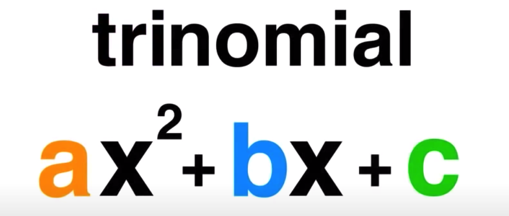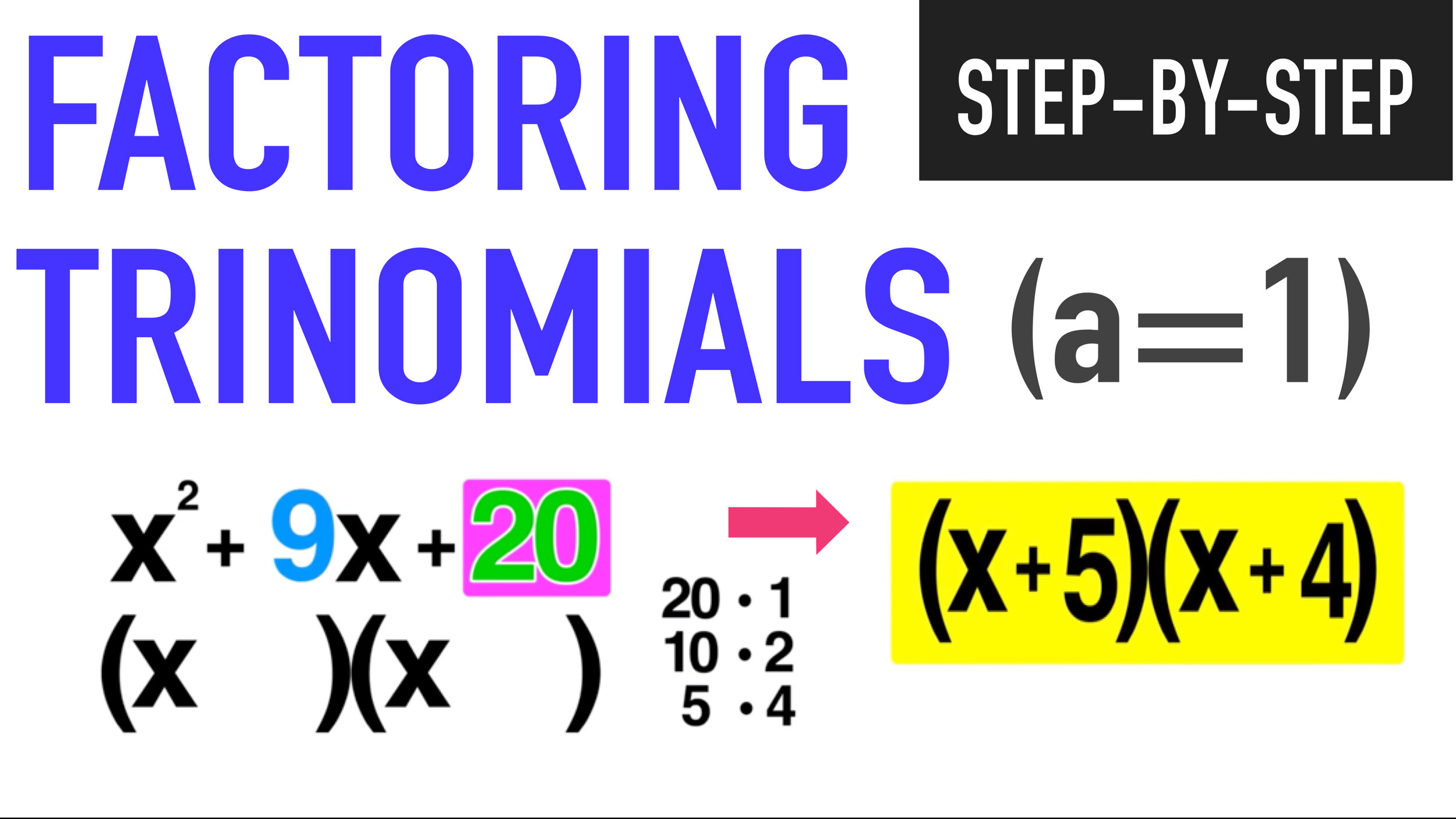How to Solve Trinomials – Learning how to factor a trinomial is an extremely important and useful algebra skill, but factoring trinomials can also be very tricky.
This free How to Factor a Trinomial step-by-step guide will teach you how to factor a trinomial when a=1 and when a does a does not equal one (more on what a refers to later) using a simple three-step process.
Before you learn how to factor a trinomial, lets do a quick review of some very important vocabulary and definitions related to trinomials.
Table of Contents
Trinomial Definition
A trinomial is a polynomial that has three terms. The first time is an x^2 term, the second term is an x term, and the third term is a constant (just a number).

Factoring a Trinomial Example 1Play Video
Furthermore, when discussing trinomials, you will see references to vales for a, b, and c., where:
a = the x^2 term coefficient
b = the x term coefficient
c= the constant value
How to Solve Trinomials
Method 1: Factoring x2 + bx + c
- 1Learn FOIL multiplication. You might have already learned the FOIL method, or “First, Outside, Inside, Last,” to multiply expressions like (x+2)(x+4). It’s useful to know how this strategy works before we get to factoring:
- Multiply the First terms: (x+2)(x+4) = x2 + __
- Multiply the Outside terms: (x+2)(x+4) = x2+4x + __
- Multiply the Inside terms: (x+2)(x+4) = x2+4x+2x + __
- Multiply the Last terms: (x+2)(x+4) = x2+4x+2x+8
- Simplify: x2+4x+2x+8 = x2+6x+8
- Understand factoring. When you multiply two binomials together in the FOIL method, you end up with a trinomial (an expression with three terms) in the form ax2+bx+c, where a, b, and c are ordinary numbers. If you start with an equation in the same form, you can factor it back into two binomials.
- If the equation isn’t written in this order, move the terms around so they are. For example, rewrite 3x – 10 + x2 as x2 + 3x – 10.
- Because the highest exponent is 2 (x2, this type of expression is “quadratic.”
- Write a space for the answer in FOIL form. For now, just write (__ __)(__ __) in the space where you’ll write the answer. We’ll fill this out as we go.
- Don’t write + or – between the blank terms yet, since we don’t know which it will be.
- Fill out the First terms. For simple problems, where the first term of your trinomial is just x2, the terms in the First position will always be x and x. These are the factors of the term x2, since x times x = x2.
- Our example x2 + 3x – 10 just begins with x2, so we can write:
- (x __)(x __)
- We’ll cover more complicated problems in the next section, including trinomials that begin with a term like 6x2 or -x2. For now, follow the example problem.
- Use factoring to guess at the Last terms. If you go back and reread the FOIL method step, you’ll see that multiplying the Last terms together gives you the final term in the polynomial (the one with no x). So to factor, we need to find two numbers that multiply to form the last term.
- In our example x2 + 3x – 10, the last term is -10.
- What are the factors of -10? What two numbers multiplied together equal -10?
- There are a few possibilities: -1 times 10, 1 times -10, -2 times 5, or 2 times -5. Write these pairs down somewhere to remember them.
- Don’t change our answer yet. It still looks like this: (x __)(x __).
- Test which possibilities work with Outside and Inside multiplication. We’ve narrowed the Last terms down to a few possibilities. Use trial and error to test each possibility, multiplying the Outside and Inside terms, and comparing the result to our trinomial. For example:
- Our original problem has an “x” term of 3x, so that’s what we want to end up with in this test.
- Test -1 and 10: (x-1)(x+10). The Outside + Inside = 10x – x = 9x. Nope.
- Test 1 and -10: (x+1)(x-10). -10x + x = -9x. That’s not right. In fact, once you test -1 and 10, you know that 1 and -10 will just be the opposite of the answer above: -9x instead of 9x.
- Test -2 and 5: (x-2)(x+5). 5x – 2x = 3x. That matches the original polynomial, so this is the correct answer: (x-2)(x+5).
- In simple cases like this, when you don’t have a constant in front of the x2 term, you can use a shortcut: just add the two factors together and put an “x” after it (-2+5 → 3x). This won’t work for more complicated problems, though, so it’s good to remember the “long way” described above.
Method 2: Factoring More Complicated Trinomials
- Use simple factoring to make more complicated problems easier. Let’s say you need to factor 3x2 + 9x – 30. Look for something that factors into each of the three terms (the “greatest common factor”, or GCF).[1] In this case, it’s 3:
- 3x2 = (3)(x2)
- 9x = (3)(3x)
- -30 = (3)(-10)
- Therefore, 3x2 + 9x – 30 = (3)(x2+3x-10). We can factor out the new trinomial using the steps in the section above. Our final answer will be (3)(x-2)(x+5).
- Look for trickier factors. Sometimes, the factor might involve variables, or you might need to factor a couple times to find the simplest possible expression. Here are a few examples:
- 2x2y + 14xy + 24y = (2y)(x2 + 7x + 12)
- x4 + 11x3 – 26x2 = (x2)(x2 + 11x – 26)
- -x2 + 6x – 9 = (-1)(x2 – 6x + 9)
- Don’t forget to factor the new trinomial further, using the steps in method 1. Check your work and find similar example problems in the example problems near the bottom of this page.
- Solve problems with a number in front of the x2. Some quadratic trinomials can’t be simplified down to the easiest type of problem. Learn how to solve problems like 3x2 + 10x + 8, then practice on your own with the example problems at the bottom of the page:
- Set up our answer: (__ __)(__ __)
- Our “First” terms will each have an x, and will multiply together to make 3x2. There’s only one possible option here: (3x __)(x __).
- List factors of 8. Our options are 1 times 8, or 2 times 4.
- Test these using the Outside and Inside terms. Note that the order of the factors matter, since the Outside term is being multiplied by 3x instead of x. Try out every possibility until you get an Outside+Inside result of 10x (from the original problem):
- (3x+1)(x+8) → 24x+x = 25x no
- (3x+8)(x+1) → 3x+8x = 11x no
- (3x+2)(x+4) → 12x+2x=14x no
- (3x+4)(x+2) → 6x+4x=10x yes This is the correct factor.
- Use substitution for higher-degree trinomials. Your math book might surprise you with an equation with a high exponent, such as x4, even after you’ve used simple factoring to make the problem easier. Try substituting a new variable that turns it into a problem you know how to solve. For example:
- x5+13x3+36x
- =(x)(x4+13x2+36)
- Let’s invent a new variable. We’ll say y = x2, and plug it in:
- (x)(y2+13y+36)
- =(x)(y+9)(y+4). Now switch back to using the original variable:
- =(x)(x2+9)(x2+4)
- =(x)(x±3)(x±2)
Method 3: Factoring Special Cases
- Check for prime numbers. Check to see if the constant in either the first or third term of the trinomial is a prime number. A prime number can be divided evenly only by itself and 1, so there is only one possible pair of binomial factors.
- For example, in x2 + 6x + 5, “5 is a prime number, so the binomial must be in the form (__ 5)(__ 1).
- In the problem 3x2+10x+8, 3 is a prime number, so the binomial must be in the form (3x __)(x __).
- For the problem 3x2+4x+1, the only possible solution is (3x+1)(x+1). (You should still multiply this out to check your work, since some expressions can’t be factored at all – for example, 3x2+100x+1 has no factors.)
- Check to see if the trinomial is a perfect square. A perfect square trinomial can be factored into two identical binomials, and the factor is usually written (x+1)2 instead of (x+1)(x+1). Here a few common ones that tend to show up in problems:
- x2+2x+1=(x+1)2, and x2-2x+1=(x-1)2
- x2+4x+4=(x+2)2, and x2-4x+4=(x-2)2
- x2+6x+9=(x+3)2, and x2-6x+9=(x-3)2
- A perfect square trinomial in the form ax2 + bx + c always has a and c terms that are positive perfect squares (such as 1, 4, 9, 16, or 25), and a b term (positive or negative) that equals 2(√a * √c).[2]
- Check whether no solution exists. Not all trinomials can be factored. If you’re stuck on a quadratic trinomials (ax2+bx+c), use the quadratic formula to find the answer. If the only answers are the square root of a negative number, no real solutions exist, so there are no factors.
- For non-quadratic trinomials, use Eisenstein’s Criterion, described in the Tips section.
Conclusion
Trinomials in the form x2 + bx + c can be factored by finding two integers, r and s, whose sum is b and whose product is c. Rewrite the trinomial as x2 + rx + sx + c and then use grouping and the distributive property to factor the polynomial.
When a trinomial is in the form of ax2 + bx + c, where a is a coefficient other than 1, look first for common factors for all three terms. Factor out the common factor first, then factor the remaining simpler trinomial. If the remaining trinomial is still of the form ax2 + bx + c, find two integers, r and s, whose sum is b and whose product is ac. Then rewrite the trinomial as ax2 + rx + sx + c and use grouping and the distributive property to factor the polynomial.
When ax2 is negative, you can factor −1 out of the whole trinomial before continuing.
